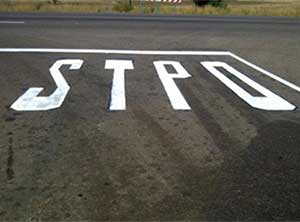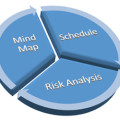
I think someone needs to pay closer attention to road!
In order to make sure that disasters like this never happen, the project manager should institute a strong system of project monitoring. Fortunately, there is plenty of information within the Project Management Body of Knowledge (PMBOK) for this. If done right, it can save your project from disaster.
In fact, the PMBOK’s project structure contains five phases, called process groups, one of which is called “Monitoring and Controlling.” Clearly this is a major focus of the guide, and a big part of project management.
This process group contains eleven processes, which are:
- Monitor and control project work. The generic process under which all other monitoring and controlling activities fall under.
- Perform integrated change control. The tasks involved with making changes to the project plan. When changes to the schedule, cost, or any other area of the project management plan are necessary, the plan is changed and re-approved by the project sponsor.
- Validate scope. The activities involved with gaining approval of the project’s deliverables.
- Control scope. Ensuring that the scope of the project does not change, and that unauthorized activities are not performed as part of the project (scope creep).
- Control schedule. The tasks involved with ensuring the project work is performed according to the schedule, and that project deadlines are met.
- Control costs. The tasks involved with ensuring the project costs stay within the approved budget.
- Control quality. Ensuring that the quality of the project’s deliverables are to the standard defined in the project management plan.
- Control communications. Providing for the communications needs of each project stakeholder.
- Control risks. Safeguarding the project from unexpected events that negatively impact the project’s budget, schedule, stakeholder needs, or any other project success criteria.
- Control procurements. Ensuring the project’s subcontractors and vendors meet the project goals.
- Control stakeholder engagement. The tasks involved with ensuring that all of the project’s stakeholders are left satisfied with the project work.
Earned Value Analysis
The bulk of a project manager’s time in the project monitoring phase will be spent on a process called Earned Value Analysis. In this system the project manager calculates the project status from two standpoints: Schedule and Cost. It can be done at any time and can give you excellent advanced warning of the project going astray.
As a minimum, the method requires the calculation of two variables:
- Cost Variance
- Schedule Variance
When the project is initially planned out, it needs to be divided into tasks, and each tasks needs two pieces of information defined:
- Budget
- Start and End Dates
The earned value calculations are performed on each task and summed to obtain variances for the whole project. To get started, the project manager needs to gather several pieces of information:
- Planned Value (PV), is the budgeted amount for each task at the specified point of analysis (usually today). This could be based on the date, for example, if the start and end dates for a task are Mar. 1 and Mar. 10, respectively, and it’s Mar. 4 today, then you could set PV = 40% of the task budget.
- Earned Value (EV), is the actual completion amount of each task relative to the task budget. You could base this on actual percent complete, for example if the work on the task is 25% complete, you could set EV = 25% of the task budget. You could also use work progress indicators, such as “20% of the concrete poured.”
- Actual Cost (AC), is the actual expenditure for each task. This is usually well tracked, but if not you might need to estimate certain things.
And now, for the calculations:
- Cost Variance (CV) is the amount that the project in a cost overrun or underrun position:
CV = EV – AC - Schedule Variance (SV) is the amount that the project is behind or ahead of schedule:
SV = EV – PV
Obviously, the cost is used as the base variable in the calculation for both cost and schedule variance, which has caused some project managers to want to express them as a percentage:
- Cost Performance Index: CPI = EV / AC
- Schedule Performance Index: SPI = EV / PV
The units of each variable does not have to be dollars. It can be hours, days, weeks, resource depletion units, etc.
Example
Let’s say you are the project manager for the renovation of 3 hotel rooms. The tasks are as follows:
- Preparation: Mar. 1-Mar. 10, $5,000
- Room #1: Mar. 10-20, $10,000
- Room #2: Mar. 15-25, $10,000
- Room #3: Mar. 20-30, $10,000
- Wrap-up: Mar. 25-31, $5,000
It’s Mar. 22 today. You figure you’re 100% complete on the preparation phase as well as Room #1, and 50% complete Room #2. Your receipts (plus timesheets, etc.) are showing $5,500 spent on preparation, $8,900 on Room #1, and $5,500 on Room #2.
| Task | PV | EV | AC | Schedule Variance | SPI | Cost Variance | CPI |
|---|---|---|---|---|---|---|---|
| Preparation | $5,000 | $5,000 | $5,500 | $0 | 1.0 | -$500 | 0.91 |
| Room #1 | $10,000 | $10,000 | $8,900 | $0 | 1.0 | $1,100 | 1.12 |
| Room #2 | $7,000 | $5,000 | $5,500 | -$2,000 | 0.71 | -$500 | 0.91 |
| Room #3 | $2,000 | $0 | $0 | -$2,000 | 0.0 | $0 | 0 |
| Wrap-up | $0 | $0 | $0 | $0 | N/A | $0 | N/A |
| TOTAL | $24,000 | $20,000 | $19,900 | -$4,000 | 0.83 | $100 | 1.0 |
In this case, we have a schedule problem (SV is negative) but not a cost problem (CV is positive). The project is behind schedule, but below budget relative to the tasks performed.
SPI = 0.83, therefore the project has completed 83% of what it should have at this point. The SPI’s of Room #2 (0.71) and Room #3 (0.0) indicate that these two tasks are creating the schedule problem.
The cost variance of $100 suggests that if everything goes according to plan in the future, the project will be $100 under budget. But since this rounds to an even 1.0 for the project, the budget is very close to where it should be.











Leave a Reply